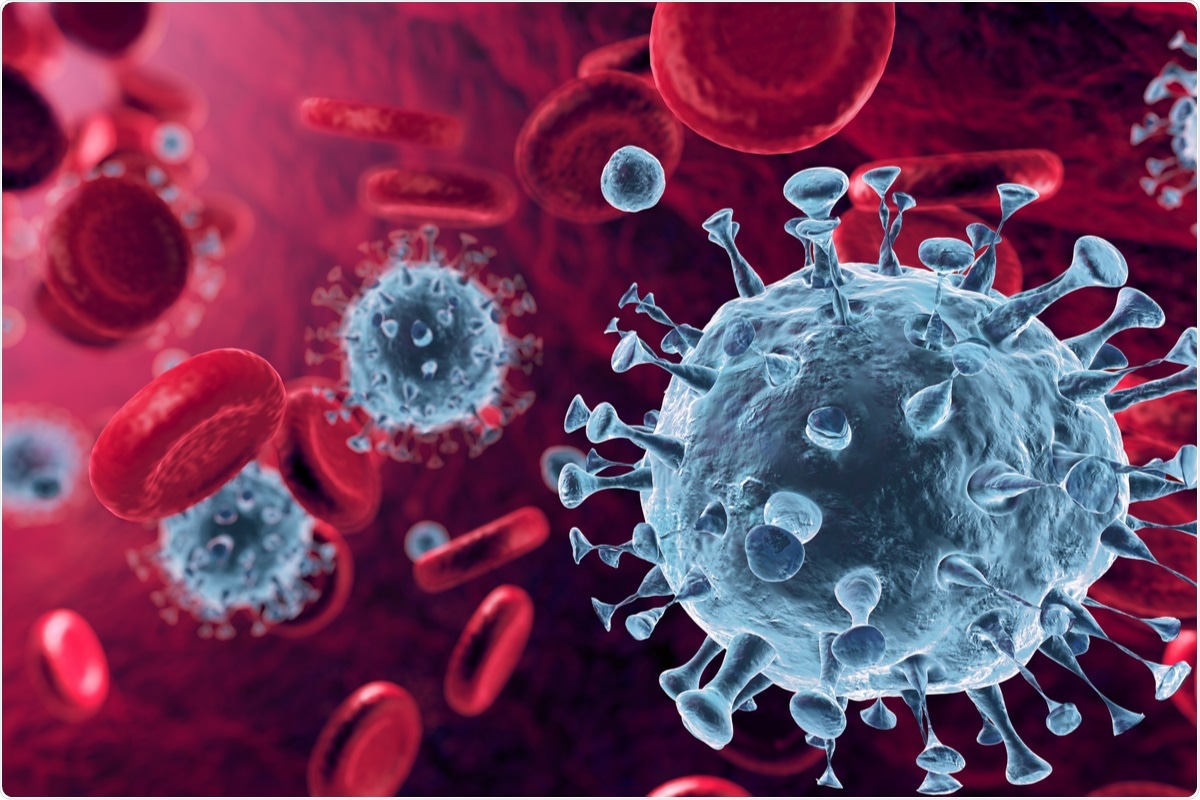γ’ fibrinogen as a disease progression marker for COVID-19

The severe acute respiratory syndrome coronavirus (SARS-CoV-2), which is the virus responsible for the coronavirus disease 2019 (COVID-19), has infected over 366 million people worldwide and killed over 5.6 million as of January 27, 2022.
 Study: Extreme γ’ fibrinogen levels in COVID-19 patients. Image Credit: Zimerch-05 / Shutterstock.com
Study: Extreme γ’ fibrinogen levels in COVID-19 patients. Image Credit: Zimerch-05 / Shutterstock.com
The progression of COVID-19 might be accompanied by a "cytokine storm," which can result in secondary complications such as thrombosis and acute respiratory distress syndrome (ARDS). Several inflammatory cytokines have been linked to COVID-19 progression, including high-sensitivity C-reactive protein (hs-CRP) and interleukin-6 (IL-6); however, the levels of these cytokines are associated with significant intra-individual variability to be effective biomarkers for monitoring disease progression.
In a recent study published on the medRxiv* preprint server, researchers discovered that the inflammatory biomarker gamma prime fibrinogen (γ' Fbg) has a six-fold lower coefficient of variability. Furthermore, the researchers found that in vitro, interleukin-6 (IL-6) upregulates messenger ribonucleic acid (mRNA) levels for the chain of γ' Fbg produced from the FGG gene by 8.3-fold, thereby suggesting that fibrinogen is a more stable and superior surrogate marker to IL-6.
Study findings
The γ' Fbg levels of COVID-19 patients were compared to historical controls from the Atherosclerosis Risk in Communities (ARIC) Study. The median γ' Fbg levels in ARIC were 29.6 mg/dL, whereas COVID-19 individuals had an average γ' Fbg level of 42.1 mg/dL.
In the ARIC trial, the highest Fbg level was 80.3 mg/dL, whereas the highest Fbg level in the COVID-19 cohort was 261 mg/dL. The ARIC research descriptive statistics for patients are not reported in this study because they are well documented.
Of the patients who developed ARDS, were placed on ECMO, or died in the hospital, several noticeable changes in their γ’ Fbg were observed. For example, the γ’ Fbg peak levels were greater in those who had ARDS, whereas patients that were placed on ECMO had considerably higher minimal γ’ Fbg levels. When compared to the patients who survived, the two patients who died had significantly higher minimum and median γ’ Fbg levels.
There were no links between high γ’ Fbg levels and venous thromboembolism (VTE) occurrences and patient summary data for the minimum and median γ’ Fbg levels were similar. The peak γ’ Fbg level of patients who had a VTE episode was somewhat lower. Comparatively, the limited number of deaths prevents the researchers from making definitive conclusions from this comparison.
Case study results
The researchers also included longitudinal case studies in their analysis. In the first case study, a male patient was hospitalized after a COVID-19 outbreak in his care facility and was suspected of being infected with SARS-CoV-2. Upon hospitalization, the diagnosis was confirmed.
On admission, chest X-rays revealed no focal consolidation; however, by day five, opacities had worsened. The clinical state of this patient deteriorated on day eight, with increased oxygen requirements and hypoxia.
On day 18, the patient made a full recovery and was discharged. A considerable increase in the patient's γ’ Fbg levels was noted on day eight, which is when the patient's γ’ Fbg levels were assessed retrospectively. As a result, there was a temporal link between the worsening of clinical symptoms and the increase in γ’ Fbg levels.
The second male patient was admitted to the emergency department 10 days after developing COVID-19 pneumonia, fever, and cough. The patient was admitted with respiratory failure requiring high flow ventilation, which was later stabilized.
Beginning on day two, eight doses of methylprednisolone were administered based on clinical symptoms. The patient recovered and was discharged on day ten.
When the patient's γ’ Fbg levels were measured retrospectively, the peak coincided with the worsening symptoms and then decreased after methylprednisone was administered. This patient had the highest γ’ Fbg level ever reported at 260 mg/dL, which accounted for 23.1% of the total fibrinogen level of 1,121 mg/dL. For comparison, γ’ Fbg levels average 7% of total fibrinogen, despite the fact that γ’ Fbg has a wide reference interval in healthy individuals ranging from 0.088-0.551 mg/dL.
Implications
The current study findings could have clinical consequences for COVID-19 patients who are taking preventive anticoagulants. Heparin prophylaxis may be less successful than treatment with other anticoagulants like direct thrombin inhibitors due to the susceptibility of γ’ Fbg-bound thrombin to heparin.
Furthermore, γ’ Fbg levels may be an essential measure of illness progression in COVID-19 patients, as γ’ Fbg appears to be involved in the coagulation abnormalities seen in these patients.
*Important notice
medRxiv publishes preliminary scientific reports that are not peer-reviewed and, therefore, should not be regarded as conclusive, guide clinical practice/health-related behavior, or treated as established information.
- Farrell, D. H., Hudkins, M., Hamilton, H., et al. (2022). Extreme γ’ fibrinogen levels in COVID-19 patients. medRxiv. doi:10.1101/2022.01.20.22269321. https://www.medrxiv.org/content/10.1101/2022.01.20.22269321v1.
Posted in: Medical Science News | Medical Research News | Disease/Infection News | Healthcare News
Tags: Acute Respiratory Distress Syndrome, Atherosclerosis, Biomarker, Coronavirus, Coronavirus Disease COVID-19, Cough, covid-19, C-Reactive Protein, Cytokine, Cytokines, ECMO, Fever, Gene, Heparin, Hospital, Hypoxia, in vitro, Interleukin, Interleukin-6, Oxygen, Pneumonia, Prophylaxis, Protein, Research, Respiratory, Ribonucleic Acid, SARS, SARS-CoV-2, Severe Acute Respiratory, Severe Acute Respiratory Syndrome, Syndrome, Thromboembolism, Thrombosis, Venous Thromboembolism, Virus
.jpg)
Written by
Colin Lightfoot
Colin graduated from the University of Chester with a B.Sc. in Biomedical Science in 2020. Since completing his undergraduate degree, he worked for NHS England as an Associate Practitioner, responsible for testing inpatients for COVID-19 on admission.
Source: Read Full Article